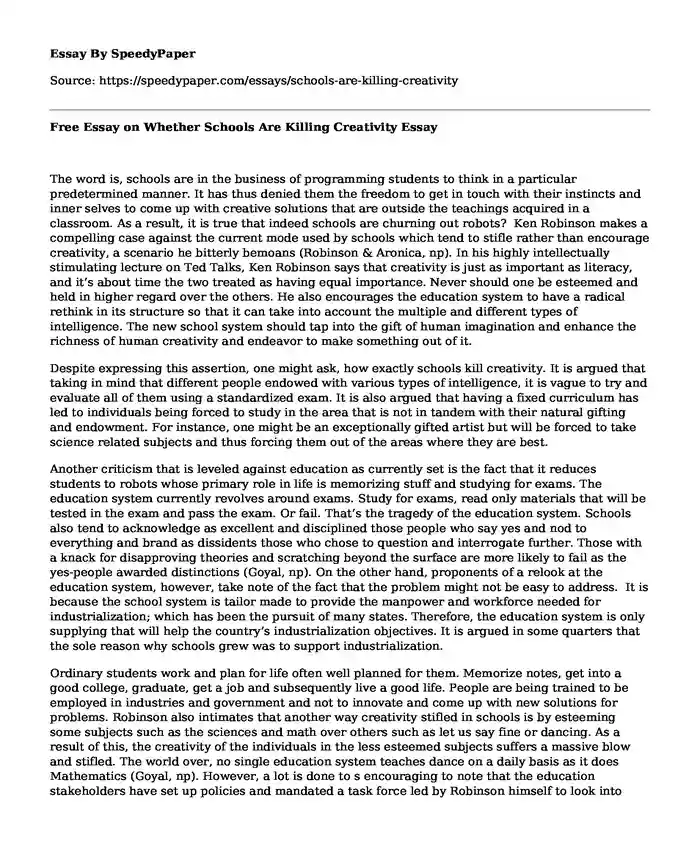The word is, schools are in the business of programming students to think in a particular predetermined manner. It has thus denied them the freedom to get in touch with their instincts and inner selves to come up with creative solutions that are outside the teachings acquired in a classroom. As a result, it is true that indeed schools are churning out robots? Ken Robinson makes a compelling case against the current mode used by schools which tend to stifle rather than encourage creativity, a scenario he bitterly bemoans (Robinson & Aronica, np). In his highly intellectually stimulating lecture on Ted Talks, Ken Robinson says that creativity is just as important as literacy, and it’s about time the two treated as having equal importance. Never should one be esteemed and held in higher regard over the others. He also encourages the education system to have a radical rethink in its structure so that it can take into account the multiple and different types of intelligence. The new school system should tap into the gift of human imagination and enhance the richness of human creativity and endeavor to make something out of it.
Despite expressing this assertion, one might ask, how exactly schools kill creativity. It is argued that taking in mind that different people endowed with various types of intelligence, it is vague to try and evaluate all of them using a standardized exam. It is also argued that having a fixed curriculum has led to individuals being forced to study in the area that is not in tandem with their natural gifting and endowment. For instance, one might be an exceptionally gifted artist but will be forced to take science related subjects and thus forcing them out of the areas where they are best.
Another criticism that is leveled against education as currently set is the fact that it reduces students to robots whose primary role in life is memorizing stuff and studying for exams. The education system currently revolves around exams. Study for exams, read only materials that will be tested in the exam and pass the exam. Or fail. That’s the tragedy of the education system. Schools also tend to acknowledge as excellent and disciplined those people who say yes and nod to everything and brand as dissidents those who chose to question and interrogate further. Those with a knack for disapproving theories and scratching beyond the surface are more likely to fail as the yes-people awarded distinctions (Goyal, np). On the other hand, proponents of a relook at the education system, however, take note of the fact that the problem might not be easy to address. It is because the school system is tailor made to provide the manpower and workforce needed for industrialization; which has been the pursuit of many states. Therefore, the education system is only supplying that will help the country’s industrialization objectives. It is argued in some quarters that the sole reason why schools grew was to support industrialization.
Ordinary students work and plan for life often well planned for them. Memorize notes, get into a good college, graduate, get a job and subsequently live a good life. People are being trained to be employed in industries and government and not to innovate and come up with new solutions for problems. Robinson also intimates that another way creativity stifled in schools is by esteeming some subjects such as the sciences and math over others such as let us say fine or dancing. As a result of this, the creativity of the individuals in the less esteemed subjects suffers a massive blow and stifled. The world over, no single education system teaches dance on a daily basis as it does Mathematics (Goyal, np). However, a lot is done to s encouraging to note that the education stakeholders have set up policies and mandated a task force led by Robinson himself to look into ways of reforming the education sector so that it can be more accommodative of students not gifted in memorizing and reproduction of knowledge during exams.
Conclusion
Education has been the force behind the change taking place across the globe. As a result of its role, most people now seek knowledge but rarely understand why they do it. On the flip side, the reason behind education has been to ensure the creation of an equipped manpower to meet the expectation. There is, however, need to transform the education system to facilitate the realization of individual potential. While so doing a lot can be realized though still complex thus may take a bit of time to accomplish.
Works Cited
Robinson, Ken, and Lou Aronica. Creative schools : the grassroots revolution that's transforming education. New York, New York: Viking, 2015. Print.
Goyal, Nikhil. Schools on trial : how freedom and creativity can fix our educational malpractice. New York: Doubleday, 2016. Print.
Cite this page
Free Essay on Whether Schools Are Killing Creativity. (2017, Oct 11). Retrieved from https://speedypaper.net/essays/schools-are-killing-creativity
Request Removal
If you are the original author of this essay and no longer wish to have it published on the SpeedyPaper website, please click below to request its removal:
- Free Essay on Globalization: Assessment of International Industry Cooperation
- Essay Example: Science and Religion in Modern Western Culture
- Religion Essay Example: Prayer in Silence
- Essay Sample: Heterosexual Construction and Regulation of Sexuality
- Paper Sample on Sexual Harassment: Violence Against Women Working in Silicon Valley
- Essay Example: Chinese Consumer Attitudes in Premium Car Segment
- Ethical Treatment of Research Participants - Paper Example
Popular categories





